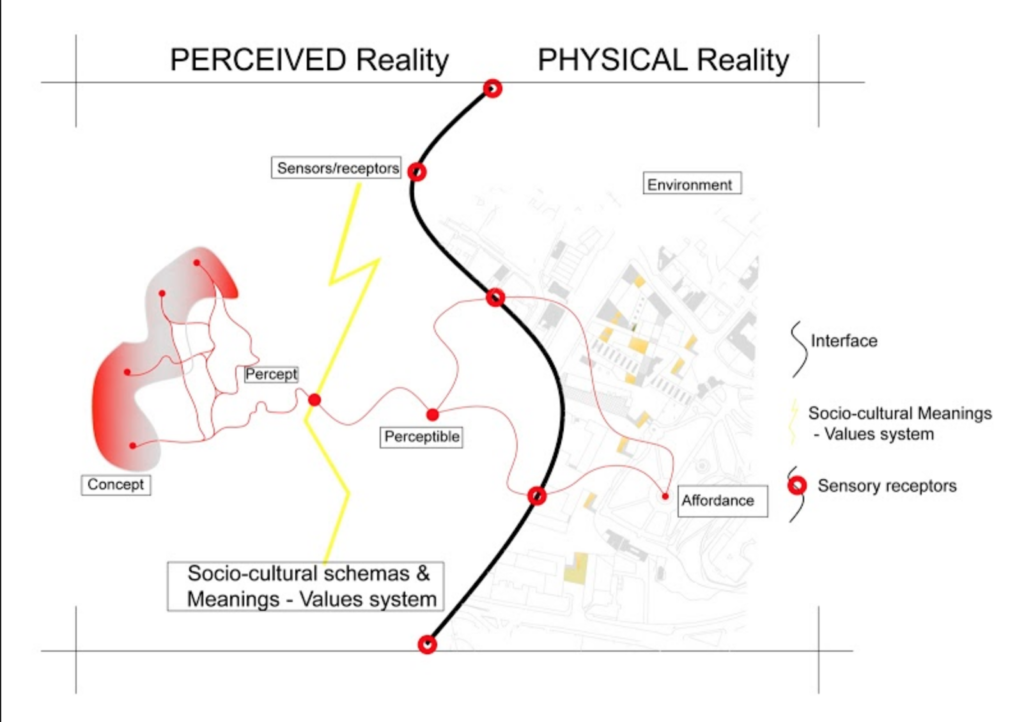Philosophy is invested in unpacking the multitude of ways that the self construes the external realm. The self’s internal and external realms are in constant conversation and negotiation with one another, both consciously and unconsciously. The result of those negotiations is the means with which the self positions and navigates through the external realm. The disciplines of psychology, neuroscience and cognitive psychology have been studying this complex process of unpacking and comprehending external realities. Recent research initiatives have brought together disciples such as neuroscience, architecture and psychology to inform the practice of environmental psychology. Design as a discipline is invested in understanding, how the urban space is perceived, interpreted and experienced by the user. Design studies have predominantly dealt with perception, to unravel (for instance) nuances of smell and soundscape design. Cognition has not been a traditionally integral part of design studies, and instead has been taken for granted in the equation. This paper reinforces the potentials of urban perceptual simulation by reviewing the relational dynamics between place and perception from the modes of perception and cognition.
By inquiring into the notions of perception and cognition, this paper provides an interdisciplinary inquiry into the relationship between place and perception. In doing so, the paper illustrates how, through an active interactional mechanism,spatial schemas bridge the external urban realm and internal perceptual realm to enable the construction of an urban narrative. The paper takes its findings a step further by proposing a city designed with ‘windows and mirrors’ to the human mind, using cognitive affordances.
Place and Perception
Perception refers to the diverse means with which the human mind senses information from the external environment. The identification, organisation and interpretation of this information is regarded as the process of cognition. The latter, perhaps due to the complex psychological construction process, has been more of an exception in design disciplinary inquiries that aim to understand the relationship between people and places. To provide an overview, aspects of experiential concerns when designing the environment was raised by Sitte10 in 1889. The component of visual legibility was further studied by Lynch5 in 1960 and Appleyard1 in 1979; their studies identified spatial components that aided visual legibility. The subjective perception of space was the primary interest of numerous studies including Whyte12 and Gehl4 in 2011 that followed and which led the interest in uncovering the subjective judgement towards a place that either brought about a sense of place/sense of belonging or its lack. The design ideology of such an approach bases itself on the understanding of subjective experience of space and regards much less of aesthetic branding as the defining quality of the urban space/place.
Any space transforms itself as a place consumed by people based on how each uniquely perceive its qualities, as opposed to being overpowered by a single aesthetic effect. Lynch regarded the act of identifying and comprehending the urban surrounding as a primal ability of the human mind with sensory feeds. Garling and Golledge3 outline the following processes:, sensing data from /about the environment, the perceptual and cognitive representation of the sensory data, and reaching at firm conclusions, choices and judgments. The sensory feeds of shape, colour, motion, light, smell, sound, and touch referred to as Visual, Auditory, Olfactory, Gustatory and Tactile aspects. A list of up to 33 sensory systems ranging from trigeminal perception, pain, balance, heat, cold, muscle behaviour, blood pressure and kinaesthetics was outlined by Durie2 as contributing to subjective experience of space and contributing factors constructing the urban narrative. These sensory feeds or sensory stimuli can transpire into perceptions that are conscious as well as unconscious. In the subjective experience there are possibilities of a dominant mode of perception in action, thus leading to a complex process that is not necessarily linear but multi-sensory and multi-layered in character.
Spatial schema and Urban Narrative:
Between place and perception is the relationship between self and space, thus socio-spatial systems needs to be built with careful consideration of the human cognitive system. Neisser’s term schematadenotes experiences of the past and expectations that may arise from them. Exploration, combined with these schemata and surrounding information from the environment form perception, according to Neisser6. This stresses the need for information from environment to connect with schemata; and in the instance where schemata does not pair with the information; perception may not occur, or lead to alteration of the schemata as the interplay between the physical realm and perceived realm feed into one another. Schema is argued to be the building block of knowledge9 and schema is regarded as ‘a cohesive, repeatable action sequence possessing component actions that are tightly interconnected and governed by a core meaning’9.
The understandings from the schemas evolve as they are exposed to numerous perceptive experiences. A representation of the process mapping of the cognitive system in action can be regarded as ‘a reflection of a representation as it arises out of contributions from both environmental and cognitive domains’8. That feature or aspect in the urban surrounding that initiates the interplay between the environment and cognitive realm is regarded as affordance and it can be cognitive, physical, perceptual and functional in nature7. Affordance is hence the trigger that kick starts perception. The stimulus from the affordance that is designed into the urban environment presents to the sensory receptors, the stimuli is then interpreted by the neurological system. The sensory information form the urban environment is referred to as perceptible. The contextual interpretation of the perceptible is the process of cognition. The accumulated memory schema embeds in itself socio-cultural meanings and values and these contribute to interpreting the perceptible. This line of interaction is mapped as a visual simulation in Figure 1. It is a visual conceptualisation where the fluid blackline divides the transition between the objective physical realm and subjective perceived realm. The affordance(s) in the urban environment feed sensory data to receptors, thus enabling the perceptible to reach the brain. The accumulated socio-cultural schemas contextualises the information, thus enabling the perceptible to lead to percepts; the significance of which is determined by the dimensions of space, time and geographical context.

Together with the dimensions of context, space and time, the socio-cultural system provides the perceptible purpose and value. The behavioural reaction induced in the human interaction with space is hence the process of the perceptible being interpreted through a socio-cultural system. The identity of the perceptible is hence a socio-cultural conditioning formed through repeated reinforcement. Such a reinforcement and a well-defined frame of spatial schemas are crucial to constructing the experiential narrative.
Designing the city as Mirrors and Windows
Affordances are what an environment offers its user. The concept of affordance has been used in graphics design, interface design and interior design. The line of communication between the people and place is negotiated through affordances that are physical, cognitive, perceptual, and socio-cultural; the common denominator achieved across a range of users leads to social cognition.Philosophy studies perception as one of the key currencies of the human mind, experiences are regarded as mental representations making the ‘essence of existence is perception’8.
Given the power of socio-cultural schemas in the way they afford cognition and construct the urban narrative, what is designed into the environment needs to serve as a window and mirror to the user. Of course, Window and mirror aren’t referred to in the literal sense, but as mechanisms; the mirror to reflect culture, known reality, and the self in new light; and the window to engage with the unknown, breaking down walls and expanding the horizon. These metaphors are recommended as a strategic approach to designing cognitive affordances. To demonstrate this with an example, a public space that utilises such a construct are the Millennium Gardens at Chicago. Its fountain projects back to visitors the faces of the city’s people, thus rooting itself in its social context. The ‘bean’ sculpture, in a literal way, acts a window by generating unique distorted view of the city’s skyline, and at once a mirror, enabling the user to view themselves in context. Aspects such as sense of belonging and sense of place are simply the products of the user identifying with their environment. Public spaces, through such mechanisms can offer a sense of meaning, value and purpose.

Efforts to create cognitive affordances attempt to bridge the socio-spatial systems that are made of ‘cultural, economic, social and political systems and the individual cognitive systems that is made of an individual’s values, desires, and ideas’.11 It is important therefore to develop such methodologies for fostering a collective sense of belonging, particularly in today’s often fragmented urban populations.
References
- Appleyard, D. The environment as a social symbol: Within a theory of environmental action and perception. Journal of the American Planning Association, 45(2), 143-153. (1979).
- Durie, B. Doors of perception. New Scientist, (2484), 33-36. (2005).
- Gärling, T., & Golledge, R. G. Environmental perception and cognition. In Advance in Environment, Behavior, and Design (pp. 203-236). Springer US. (1989).
- Gehl, J. Life between buildings: using public space. Island Pres. (2011).
- Lynch, K. The image of the city (Vol. 11). MIT press. (1960).
- Neisser, U. Cognition and Reality. S. Francisco, CA: Freeman (1976)
- Norman, D. A. Cognitive engineering. In D. A. Norman & S. W. Draper (Eds.), User centered system design: New perspectives on human-computer interaction (pp. 31 – 61). Hillsdale, NJ: Erlbaum. (1986).
- Nisha, B. Attention Perception and Social Cognition: Bridging the Gap Between the Physical and Perceived. In Handbook of Research on Perception-Driven Approaches to Urban Assessment and Design (pp. 458-476). IGI Global. (2018).
- Piaget, J., & Cook, M. T. The origins of intelligence in children. New York, NY: International University Press. (1952).
- Sitte, C. The Art of Building Cities: City Building According to its Artistic Principles. (1889).
- Wachowicz, M., Vullings, L. A. E., van den Broek, M., & Ligtenberg, A. Games for interactive spatial planning: SPLASH a prototype strategy game about water management (No. 667). Alterra. (2003).
- Whyte, W. H. The social life of small urban spaces. (1980)

